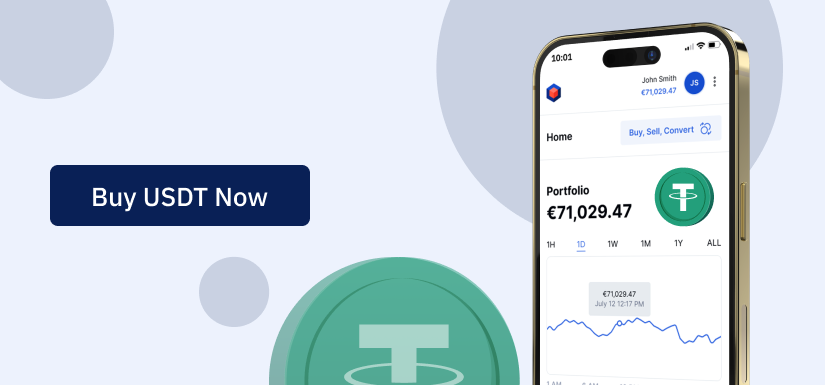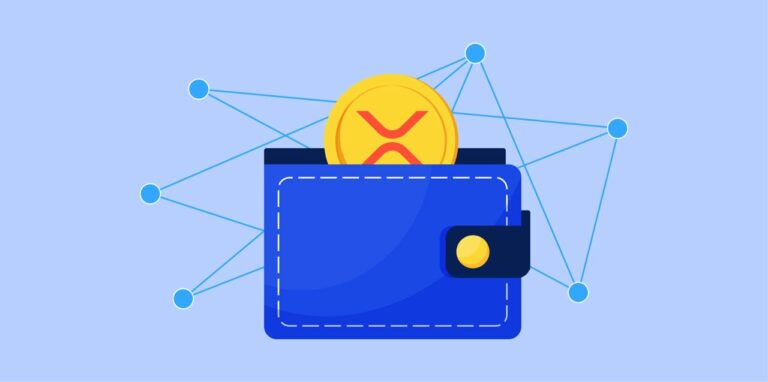In this guide, we’ll explore what exactly USDT is, the controversy around Tether’s business operations, how USDT maintains its peg to the USD, the role it plays in the crypto ecosystem, and more. By the end, you’ll have a solid understanding of this unique digital asset and its impact on the cryptocurrency sphere. So, let’s get started.
What is Tether?
As mentioned, Tether (USDT) is a stablecoin that launched in 2014 under the original name Realcoin. It was founded by the company Tether Limited to act as a digital, blockchain-based version of the U.S. dollar. In November 2014, Realcoin rebranded to the now widely recognized name, Tether, aiming to solve the biggest problem facing cryptocurrencies – volatility. By pegging its value to the dollar, Tether could provide stability amidst the turbulence of the crypto markets. So, each Tether token is designed to be worth exactly $1 USD.
When Tether first launched, its tokens were issued on the Bitcoin blockchain by utilizing the Omni Layer protocol. This allowed it to create and trade tokens on top of Bitcoin’s blockchain. Later on, Tether expanded to other blockchains, issuing tokens as ERC-20 tokens on Ethereum, TRC-20 tokens on Tron, and on Algorand, Solana, Avalanche, and others. This cross-blockchain interoperability increased its utility.

The fundamental concept behind Tether is that it is backed 1-to-1 with real U.S. dollar reserves. Tether Limited claims to hold sufficient dollar reserves to match the number of USDT tokens in circulation. This backing is what gives Tether its value and peg to the dollar.
For example, for every 1 USDT token issued, Tether claims to have $1 USD in bank reserves to back that token. This allows any holder to theoretically redeem their USDT for the equivalent dollars from Tether Limited at any time.
Tether’s role as a stablecoin is to allow cryptocurrency users to easily move between positions without losing value due to volatility. Traders can use USDT to stabilize their portfolio during times of extreme market turbulence. Tether also enables fast and simple transfers between different exchanges and cryptocurrencies.
However, Tether has faced extensive scrutiny and controversy regarding the validity of its 1:1 dollar peg and reserves. There have been allegations that Tether does not truly have sufficient dollar reserves to back all USDT in circulation. Nonetheless, it remains one of the most widely used stablecoins.
After understanding the fundamentals of Tether (USDT), it’s worthwhile to note that there are other stablecoins in the market that offer similar features with slight variations. One of the main competitors to Tether is USDC. For a deeper dive into how these stablecoins compare, be sure to read our comprehensive breakdown titled “Tether vs USDC“. In the guide, we scrutinize both Tether and USDC to uncover the nuanced ways they differ.
How Does Tether Work?
Tether operates on a reserve system that underpins its ability to maintain a 1:1 peg with the U.S. dollar. When a user deposits $1 USD with Tether Limited, the company issues 1 USDT token for that user. This expands the Tether supply and also adds $1 to its dollar reserves. The user can then withdraw the USDT token to their cryptocurrency wallet and use it for trading, transactions, etc.

Conversely, if a user redeems USDT tokens from Tether for USD, the tokens are destroyed and removed from circulation. An equivalent amount is deducted from Tether’s reserves. This contraction balances the previous expansion.
By increasing and decreasing the USDT supply via this reserve system, Tether can maintain the 1:1 peg even as demand fluctuates. If demand for USDT rises, Tether mints more tokens. If it falls, tokens are destroyed. This helps stabilize the price around $1 USD.
Tether publishes periodic attestations conducted by accounting firms that are supposed to prove it has sufficient reserves to back all USDT in circulation 1-to-1 with dollars. However, the vagueness and lack of official audits have led to extensive criticisms about Tether’s reserves.
The company was notoriously opaque about its holdings and business practices in its early years. Concerns arose that Tether did not actually hold enough reserves to redeem all tokens, thereby putting its dollar peg at risk.
Tether settled a case in 2021 brought by the New York Attorney General regarding these reserves. As part of the settlement, Tether agreed to release quarterly breakdowns of its reserves. It claims to now hold its reserves 100% in cash and cash equivalents.
Nonetheless, many critics remain skeptical of Tether’s reserves and its ability to maintain the 1:1 dollar peg if redeemals sharply increase. They argue that Tether still lacks transparency and sufficient collateral to confidently guarantee each USDT is redeemable for $1.
Despite the controversies, the Tether reserve system has generally maintained a steady dollar value for USDT, with only brief deviations from the peg. This price stability amidst crypto volatility is why it remains popular among traders and exchanges. However, doubts linger whether Tether truly has the reserves to honor full-scale redemptions.
Uses and Benefits of Tether
As a stablecoin pegged to the U.S. dollar, Tether provides unique utility in the volatile world of cryptocurrency. Here are some of the main uses and benefits of USDT:
- Trading – Tether’s price stability makes it ideal for trading between different cryptocurrencies. Traders can seamlessly move in and out of crypto positions without losing value due to price fluctuations. This allows them to act fast on trading opportunities without volatility risk.
- Store of Value – Cryptocurrencies are infamously volatile assets. Tether provides a stable store of value to take temporary shelter when crypto markets get turbulent. Holding USDT protects value much better than leaving funds in volatile coins.
- Fiat On/Off Ramp – Tether enables easy flow of funds between fiat currencies and crypto. Users can keep value parked in USDT when not actively trading instead of converting back to bank-held dollars.
- Settlements – Tether allows faster, cheaper settlements between parties compared to traditional bank wire transfers. This is especially useful for exchanges, OTC desks, and cross-border partner payments.
- Lending/Borrowing – In decentralized finance (DeFi) protocols, Tether provides stable liquidity for crypto lending/borrowing and other financial services without volatility risk.
- Remittances – Tether offers a low-cost way to transfer funds globally by avoiding high fees and long transfer times associated with banks. Its stability also prevents losses from currency fluctuations.
Overall, Tether fulfills multiple roles in the cryptocurrency ecosystem thanks to its reliable dollar peg and swift transfer speeds. However, realization of these benefits relies on maintaining user confidence in Tether’s dollar reserves and 1:1 redeemability.
USDT Risks and Controversies
Since its inception, Tether has been shrouded in controversy regarding the validity of its business model and operations. While Tether claims to be 100% backed by reserves, many critics have raised serious doubts. Here are some of the main risks and controversies associated with Tether:
- Regulatory Uncertainty – As an unregulated stablecoin, Tether operates in murky legal territory. It faces investigations and the threat of being shut down if deemed illegal by authorities. An adverse regulatory decision could be catastrophic.
- Reserve Adequacy – Tether’s lack of official audits means the true state of its reserves is uncertain. Experts question if Tether actually holds enough assets to redeem all USDT tokens at $1 as claimed. A fractional reserve could jeopardize the peg.
- Market Manipulation – Academic studies have accused Tether of printing unbacked USDT to artificially pump up Bitcoin prices during past rallies. If true, this market manipulation endangers the entire cryptocurrency market.
- NY Attorney General Lawsuit – In 2021, Tether settled a case alleging it had loaned reserve funds to cover losses. Tether paid an $18.5 million fine but admitted no wrongdoing. Nonetheless, it raised concerns.
- Loss of Confidence – Perhaps the greatest risk is a “bank run” if faith in Tether’s reserves is lost. Mass redemptions could collapse the peg and wipe out much of the crypto market value given USDT’s integral role.
Tether occupies a precarious position as the largest and most widely used stablecoin. But persistent doubts around its opaque operations and true reserve holdings continue to raise red flags. While Tether rejects these criticisms, many believe regulatory action or loss of confidence inevitable. The fallout for the broader crypto market could be immense given USDT’s systemic importance.
Storing and Using Tether
Having established ‘What is USDT’ and its core functions, let’s talk about how one can store and use this stablecoin. Once you acquire Tether tokens, you need a secure place to store them, as well as options to use USDT for trading and transactions. Here are some key considerations:
- Wallets – You can store USDT in software, hardware, custodial, or non-custodial wallets. Software and hardware wallets offer more security but require more responsibility. Custodial wallets are convenient but have counterparty risk.
- Security Tradeoffs – With any wallet, assess aspects like private key management, backup features, and cybersecurity. For significant USDT holdings, a hardware wallet like Ledger offers top security.
While understanding how to store and use Tether is essential, choosing the right wallet to ensure safety and convenience is just as crucial. If you’re keen on finding out the best wallets tailored for Tether storage and transactions, we’ve compiled a comprehensive guide to help you out. Check out our detailed article on the Best Tether Wallet to make an informed decision.
Purchasing USDT
Most major exchanges like Coinbase, Kraken, and Binance offer USDT trading pairs, allowing you to buy Tether with fiat currency or cryptocurrencies like Bitcoin. Exchanges need to be vetted for factors like fees, limits, and reputation. Need an easy way to get your hands on some USDT? Check out our guide on how to Buy Tether with a Debit Card here.

Using USDT
Once you have USDT, it can be used for trading, lending, payments, and more on supported platforms. For example, you can trade cryptocurrency pairs using USDT on exchanges or earn interest by lending USDT through DeFi protocols.
Overall, choose a secure storage solution you’re comfortable with, select a reputable exchange based on your needs, and take advantage of the myriad uses now available for your USDT, from trading to lending and beyond. As with all cryptocurrency, educating yourself on best practices is key to using USDT safely and effectively.
Tether’s Future Role and Conclusion
Looking ahead, as we reflect on ‘What is USDT’ and its impact, it’s clear that Tether will continue to play a pivotal role in the crypto ecosystem. Tether stands out as an early stablecoin innovator that provides meaningful utility like price stability, trading liquidity, and fiat gateways for the often volatile cryptocurrency landscape. However, doubts remain around Tether’s reserve holdings and business operations that could put its sustainability at risk.
Moving forward, Tether must focus on improving transparency around its reserves and complying with potential new regulatory frameworks for stablecoins. This will help restore confidence in USDT being truly pegged 1-to-1 with dollars in the bank. Tether also needs contingency plans in case a “bank run” exceeds its available liquidity.
If handled properly, Tether can continue serving a useful role as a stable hedging tool and settlement asset that unlocks unique financial opportunities using blockchain technology. But resilience and adaptability will be required as adoption spreads beyond trading into payments, DeFi, and more.
In the right regulatory environment with bulletproof reserves, Tether’s future looks bright. But substandard transparency or fractional backing could spell its downfall. Only time will tell if Tether can overcome past controversies and cement its place as a foundational stablecoin.
FAQs
Bank transfers are known for their security and larger transaction capabilities. Check out our guide to Buy Tether with Bank Transfer for a detailed walkthrough.
USDT, also known as Tether, is generally utilized as a stablecoin to counter cryptocurrency instability by representing a 1:1 ratio with the US dollar.
Though USDT intends to keep a 1:1 parity with the American dollar, minor fluctuations can happen depending on supply and demand. Overall however, the fluctuations are typically smaller compared to alternate cryptocurrencies.





